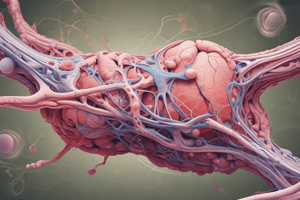Podcast
Questions and Answers
What is the main function of epithelial tissue?
What is the main function of epithelial tissue?
- Form protective barriers over organs and control fluid exchange (correct)
- Connect different parts of the body through networks of blood vessels
- Provide support, cushioning, and protection
- Responsible for movement and contraction within the body
Which type of tissue is mainly responsible for providing support and connecting different parts of the body?
Which type of tissue is mainly responsible for providing support and connecting different parts of the body?
- Muscle tissue
- Epithelial tissue
- Connective tissue (correct)
- Nervous tissue
Which tissue type is primarily found in outer layers like skin?
Which tissue type is primarily found in outer layers like skin?
- Muscle tissue
- Connective tissue
- Epithelial tissue (correct)
- Nervous tissue
What is the primary function of muscle tissue?
What is the primary function of muscle tissue?
In an organism's body, which type of tissue contracts when stimulated by signals from nerves?
In an organism's body, which type of tissue contracts when stimulated by signals from nerves?
What is the main role of connective tissue in the body?
What is the main role of connective tissue in the body?
What is the primary function of tissues?
What is the primary function of tissues?
What is the main component of bone tissue responsible for forming a strong skeletal structure?
What is the main component of bone tissue responsible for forming a strong skeletal structure?
Which type of tissue is made up mostly of keratinocytes, sweat glands, sebaceous glands, and hair follicles?
Which type of tissue is made up mostly of keratinocytes, sweat glands, sebaceous glands, and hair follicles?
Which type of tissue functions in transporting oxygen and nutrients around the body?
Which type of tissue functions in transporting oxygen and nutrients around the body?
What is the main function of nervous tissue in the body?
What is the main function of nervous tissue in the body?
Why is understanding tissues important in biological education?
Why is understanding tissues important in biological education?
Flashcards are hidden until you start studying
Study Notes
Education in Science and Biology: Understanding Cells Through Tissues
Educating students about cells is a fundamental part of any biology curriculum. At its core, education in this area involves understanding different types of cellular structures, their functions, and how they work together within living organisms. One key aspect of this study is tissues, which refers to groups of similar cells that work together to perform various tasks within an organism's body. This section will explore what tissues are, why they are important, and some common examples.
What Are Tissues?
Tissues refer to groups of specialized cells that work together to perform specific functions within an organism’s body. There are four main types of tissue: epithelial, connective, muscle, and nervous tissues. Each type has distinct characteristics that allow it to carry out certain duties:
- Epithelial tissue: Found primarily in outer layers like skin, these cells form protective barriers over organs and help control fluid exchange between the outside world and internal systems.
- Connective tissue: Provides support, cushioning, and protection, while also connecting other parts of the body through complex networks of blood vessels, nerves, muscles, and other tissues.
- Muscle tissue: Responsible for movement, contraction, and expansion within the body; contracts when stimulated by signals sent from nerves.
- Nervous tissue: Controls many aspects of the body, including growth, development, and responses to changes in external conditions. It consists mainly of nerve cells called neurons, which transmit messages throughout the body via electrical impulses.
Why Are Tissues Important?
The primary function of tissues is to enable cell specialization. As organisms grow larger, there becomes too much pressure on individual cells to handle all responsibilities alone. So instead, each group of similar cells works together, forming tissues, to ensure every job gets done efficiently. Additionally, tissues serve several other purposes, such as providing structural integrity, preventing dehydration, facilitating communication among cells, protecting against injury, controlling temperature regulation, and allowing cells to move more easily.
Examples of Common Tissues
Some common types of tissues include:
- Skin: Made up mostly of keratinocytes, sweat glands, sebaceous glands, and hair follicles, skin provides physical protection, helps regulate body temperature, and enables sensory perception.
- Bone: A type of dense connective tissue made of calcium phosphate crystals embedded in collagen fibers, bone forms strong skeletal structure and protects vital organs inside the torso.
- Blood: Blood is composed of red blood cells, white blood cells, platelets, proteins, salts, sugars, lipids, and water, functioning in transporting oxygen and nutrients around the body.
- Heart muscle tissue: Specialized cardiac muscle cells contract rhythmically throughout life without fatigue, enabling continuous pumping action required for blood flow circulation.
In conclusion, understanding tissues in the context of biological education is essential because it allows us to comprehend how individual cells work collectively within the human body. By studying them closely, we can gain insight into various processes such as organ formation, disease prevention, regeneration, wound healing, and overall health maintenance.
Studying That Suits You
Use AI to generate personalized quizzes and flashcards to suit your learning preferences.




